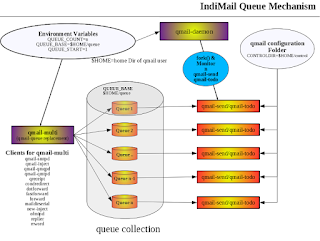Client Setup
QMQP provides a centralized mail queue within a cluster of hosts. QMQP clients do not require local queue for queueing messages. For a minimal QMQP client installation, you need to have the following
- forward, qmail-inject, sendmail, predate, datemail, mailsubj, qmail-showctl, maildirmake, maildir2mbox, maildirwatch, qail, elq, and pinq in /usr/bin;
- All files in /usr/lib, or /usr/lib64
- a symbolic link to qmail-qmqpc from /usr/sbin/qmail-queue;
- symbolic links to /usr/bin/sendmail from /usr/sbin/sendmail and /usr/lib/sendmail;
- all the manual pages in /usr/share/man;
- a list of IP addresses of QMQP servers, one per line, in /etc/indimail/control/qmqpservers;
- a copy of /etc/indimail/control/me, /etc/indimail/control/defaultdomain, and /etc/indimail/control/plusdomain from your central server, so that qmail-inject uses appropriate host names in outgoing mail; and
- this host's name in /etc/indimail/control/idhost, so that qmail-inject generates Message-ID without any risk of collision.
Remember that users won't be able to send mail if all the QMQP servers are down. Most sites have two or three independent QMQP servers.
Note that users can still use all the qmail-inject environment variables to control the appearance of their outgoing messages.
If you want to setup a SMTP service, it might be easier to install the entire IndiMail package and remove the services qmail-send.25, indisrvr.4000, proxy-imap*, proxy-pop3*, qmail-imap*, qmail-pop3*, qmail-qm*. You can use svctool to remove the service e.g.
% sudo /usr/sbin/svctool --rmsvc qmail-send.25
In case the mails generated by the client is to be relayed to the outside world, you should set the SMTP service and have /usr/sbin/sendmail, /usr/lib/sendmail linked to /usr/bin/sendmail.sh. This is to ensure that tasks like virus scanning, dk, dkim signing happen at the client end. You can also choose not to have these tasks done at the client end, but rather have it carried out by the QMQP service.
QMQP Service
IndiMail runs a QMQP service which handles incoming QMQP connections on port 628 using tcpserver. It uses multilog to store log messages under /var/log/indimail/qmqpd.628
If you have installed IndiMail using the RPM, QMQP service is installed by default. However, you need to enable it.
% sudo /bin/rm /service/qmail-qmqpd.628/down
% sudo /usr/bin/svc -u /service/qmail-qmqpd.628
If you have installed IndiMail using the source, you may create the QMQP service using the following command
% sudo /usr/sbin/svctool --qmqp=628 --servicedir=/service \
--qbase=/var/indimail/queue --qcount=5 --qstart=1 \
--cntrldir=control --localip=0 --maxdaemons=75 --maxperip=25 \
--fsync --syncdir --memory=104857600 --min-free=52428800
The above command will create a supervised service which runs qmail-qmqpd under tcpserver. In case you are setting up this service to relay mails to outside world, you might want to also specify --dkfilter, --qhpsi, --virus-filter, etc arguments to svctool(8) so that tasks like virus scanning, dk, domainkey signing, etc is done by the QMQP service.
A QMQP server shouldn't even have to glance at incoming messages; its only job is to queue them for qmail-send(8). Hence you should allow access to QMQP service only from your authorized clients. You can edit the file /var/indimail/etc/tcp.qmqp to grant specific access to clients. If you make changes to tcp.qmqp, don't forget to run the qmailctl command
% sudo /usr/bin/qmailctl cdb
Note: Some of the tasks like virus/spam filtering, dk, dkim signing, etc can be done either by the client (if QMAILQUEUE=/usr/bin/qmail-multi), or can be performed by QMQP service if QMAILQUEUE is defined as qmail-multi in the service's variable directory.

5 comments:
Let me know the deference between QMTP & QMTP. How to configure both & use it with any email client like ms-outlook
I am so confuse about it's uses
Normally when you inject a mail on a host, it is first queued on the local filesystem. After that the MTA picks up mails from the local filesystem and dispatches it for delivery. Most remote delivery are done using SMTP protocol.
Instead of using SMTP, some MTA can use QMTP to dispatch the mails to the remote host. In such cases, the remote host should support the QMTP protocol.
QMQP is totally different. You can use it to queue mails on a remote host without involving a local queue on the local filesystem.
QMQP or QMTP can be used between your own mail servers. You can use QMTP for mail exchanges between your mail server and a foreign mail server if the foreign mail servers also supports QMTP.
Outlook is a dumb client. It can neither use QMQP or QMTP.
> You can use QMTP for mail exchanges between your mail server and a foreign mail server if the foreign mail servers also supports QMTP.
that means if have configured QMTP we cannot utilize it, while remote mail server is not supported.
Also guide me for enable QMTP on INDIMAIL.
> that means if have configured QMTP we cannot utilize it, while remote mail server is not supported.
Yes. The remote mail server has to support QMTP
> Also guide me for enable QMTP on INDIMAIL
Will be glad to help. Can you join the indimail mailing list at
http://groups.google.com/group/indimail
Thanks for the detailed explanation on setting up and using QMQP! Your guide on client setup and service configuration is incredibly useful for ensuring efficient mail delivery and management. The step-by-step instructions for linking files, managing services, and configuring QMQP to work with SMTP services are clear and practical. Your tips on maintaining service access and handling mail relays are particularly valuable. This information will definitely help in optimizing mail server performance and reliability. Thanks for sharing this comprehensive guide!
Post a Comment